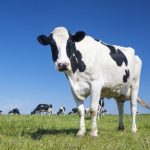 Food
Food  Food
Food  History
History 10 Odd Things Colonial Americans Kept at Home
 Weird Stuff
Weird Stuff 10 Superstitious Beliefs That Once Consumed Entire Cultures
 History
History 10 Bizarre Friendly Fire Incidents in Military History
 Technology
Technology 10 Modern Technologies That Accidentally Imitate Ancient Magic
 Mysteries
Mysteries 10 Mysteries of the Human Genome
 Weird Stuff
Weird Stuff 10 Things So Rare They’ve Only Been Found Once
 History
History 10 Legends Whose Last Moments Undid Their Glory
 Health
Health 10 Futuristic Ideas to Treat Common Medical Problems
 Weird Stuff
Weird Stuff Ten Surreal Attempts to Reverse Baldness
 Food
Food 10 Everyday Foods You Didn’t Know Were Invented by the U.S. Military
 History
History 10 Odd Things Colonial Americans Kept at Home
 Weird Stuff
Weird Stuff 10 Superstitious Beliefs That Once Consumed Entire Cultures
Who's Behind Listverse?

Jamie Frater
Head Editor
Jamie founded Listverse due to an insatiable desire to share fascinating, obscure, and bizarre facts. He has been a guest speaker on numerous national radio and television stations and is a five time published author.
More About Us History
History 10 Bizarre Friendly Fire Incidents in Military History
 Technology
Technology 10 Modern Technologies That Accidentally Imitate Ancient Magic
 Mysteries
Mysteries 10 Mysteries of the Human Genome
 Weird Stuff
Weird Stuff 10 Things So Rare They’ve Only Been Found Once
 History
History 10 Legends Whose Last Moments Undid Their Glory
 Health
Health 10 Futuristic Ideas to Treat Common Medical Problems
 Weird Stuff
Weird Stuff Ten Surreal Attempts to Reverse Baldness
Making 10 Common Products from Very Unusual Sources
In a world focused on sustainability and innovation, everyday products are being transformed in surprising ways. From the clothes we wear to the food we eat, traditional materials are being replaced with unconventional ones, pushing the boundaries of possibility.
This list explores ten everyday products made from unusual sources. Each entry not only surprises but also showcases the creativity and potential of thinking outside the box. As we uncover these innovations, we glimpse a future where sustainability and practicality go hand in hand.
Related: 10 Planet-Saving Inventions That You May Not Know Much About
10 Beet Brine as a Road De-Icing Solution
Road salt has long been used to keep winter roads safe, but its environmental impact is significant, damaging soil, vegetation, and water systems. Researchers have been exploring alternative de-icing methods, and beet juice has emerged as a promising option. This solution combines beet juice with salt, reducing the overall amount of salt needed and thus mitigating some environmental harm.
Beet juice works by lowering the freezing point of water, making it effective in preventing ice formation. This allows for safer roads with less environmental degradation. The brine is sticky, which helps it adhere to roads better than traditional salt, meaning it stays effective for a longer period and requires fewer applications. This saves money and reduces the labor and resources needed for road maintenance.
While it has some drawbacks, like its strong odor and potential to attract wildlife, beet juice is less harmful to aquatic life than traditional salt. This innovative approach shows how agricultural byproducts can be repurposed for environmental benefits, offering a more sustainable solution for winter road safety.[1]
9 Creating Concrete Using Recycled Glass
Using waste glass in concrete mixes is an innovative approach to reducing environmental impact. When ground into a fine powder, waste glass acts as a pozzolan, enhancing the concrete’s strength and durability. This glass-based sand improves workability during the mixing phase and provides greater freeze-thaw resistance once hardened. This method reduces the need for traditional sand and diverts significant amounts of glass waste from landfills.
Additionally, using waste glass as an aggregate in concrete can further reduce environmental impacts. However, careful management is required to prevent alkali-silica reaction (ASR), a chemical reaction that can weaken the concrete. The negative effects of ASR can be mitigated by incorporating supplementary cementitious materials like silica fume or fly ash. This innovative use of glass supports recycling efforts and creates a more sustainable construction material.[2]
8 Turning Cacti into Sustainable Leather
Cactus leather is an innovative and sustainable alternative to traditional leather, made from the nopal cactus, also known as the prickly pear. This process involves harvesting mature cactus pads, which are then cleaned, smashed, and left to dry in the sun. The resulting fibers are transformed into a liquid bio-resin that can be used to create a durable, flexible material suitable for fashion items like handbags, shoes, and even car interiors.
The environmental benefits of cactus leather are significant. The prickly pear cactus is drought-resistant, requiring minimal water and no pesticides, making it ideal for arid regions. Its cultivation helps sequester carbon, aiding in climate change mitigation. Additionally, the production process is energy-efficient, relying on natural sunlight for drying and using organic dyes, reducing the overall environmental footprint.
While cactus leather is relatively new, it holds promise as a viable and eco-friendly leather alternative. Its durability and minimal environmental impact make it a compelling choice for sustainable fashion and other applications, reflecting a growing trend toward environmentally conscious materials in various industries.[3]
7 Crafting Butter from CO2 and Hydrogen
Imagine making butter without cows—just air and water. Savor, a startup supported by Bill Gates, is doing just that. They capture carbon dioxide from the air and hydrogen from water, then combine these elements to create fatty acids. These acids are turned into a butter-like product that tastes and feels like the real thing but without the environmental downsides of dairy farming.
This method slashes greenhouse gas emissions and avoids the deforestation linked to palm oil production. Plus, it’s super efficient, using minimal water and no land. While it might sound odd at first, this lab-made butter could be a game-changer in sustainable food production, offering a way to enjoy creamy spreads without harming the planet.[4]
6 Creating Biodiesel from Algae
Thanks to their high oil content and quick growth, algae are turning heads as a future fuel source. Unlike crops like corn or soy, algae can be grown in non-arable areas using various water types, including salty and wastewater. This means they don’t compete with food crops and are easier on the environment. Their high productivity per acre makes them an efficient biofuel option.
The process of making biodiesel from algae involves extracting oils and converting them into biodiesel through a method called transesterification. This produces a fuel similar to traditional diesel but with a much smaller carbon footprint. Despite its promise, producing algae biodiesel at scale is challenging. Researchers are focused on finding better strains of algae, optimizing how they’re grown, and improving oil extraction methods to make this green fuel more affordable.
If these hurdles can be cleared, algae could play a significant role in the shift toward sustainable energy. Imagine a future where vast algae farms not only produce fuel but also help clean wastewater and reduce carbon emissions. It’s a win-win scenario that could transform our approach to energy.[5]
5 Clothing Made from Pineapple Leaves
Pineapple leaves, usually considered agricultural waste, are now being transformed into a sustainable textile known as Piñatex. This innovative fabric is made from the long fibers of pineapple leaves, which are extracted, cleaned, and processed into a non-woven mesh. This mesh is then treated to create a versatile material that can be used for making clothes, shoes, and even furniture.
The environmental benefits of using pineapple leaves for fabric are substantial. Piñatex production requires no additional land, water, fertilizers, or pesticides, as it uses byproducts of existing pineapple agriculture. This reduces waste and provides an additional income stream for farmers. Moreover, Piñatex is biodegradable and offers a vegan alternative to leather, aligning with the growing demand for eco-friendly and cruelty-free products.
The popularity of Piñatex is growing in the fashion industry, with several designers and brands incorporating this sustainable material into their collections. Its unique texture and eco-friendly credentials make it an appealing choice for consumers looking to make more sustainable fashion choices. This innovative use of pineapple leaves highlights how agricultural byproducts can be repurposed to create environmentally friendly products.[6]
4 Corn-Based Milk: A New Dairy Alternative
Maïzly, a notable entry in the Consider Corn Challenge IV, has developed a plant-based milk derived from corn. This innovative milk mimics the texture and flavor of traditional dairy milk, making it suitable for various culinary uses. It’s available in flavors like original, chocolate, vanilla, and strawberry, providing diverse options for consumers.
In addition to beverages, Maïzly has created lactose-free infant formulas from corn milk. These formulas meet CODEX standards and are designed to address malnutrition in regions like Sub-Saharan Africa. Maïzly’s corn-based products offer a sustainable and nutritious alternative to conventional dairy.[7]
3 Making Flour from Crickets
Cricket flour, or Acheta protein, is becoming a popular alternative protein source due to its high protein content, reaching up to 77% when ground into powder. This makes it a highly efficient and dense protein option, often used in protein bars, smoothies, and baked goods. The slightly nutty taste of cricket flour allows it to blend well into various recipes without overpowering other flavors.
In addition to protein, cricket flour is packed with essential nutrients such as B vitamins, iron, and magnesium, and it also provides fiber, which is rare in many other protein sources. These nutritional benefits make it a compelling option for those looking to diversify their dietary protein intake while also gaining additional health benefits.
Environmentally, cricket farming is far more sustainable than traditional livestock farming. It requires significantly less land, water, and feed, making it an eco-friendly choice. This sustainable practice helps reduce the environmental impact of food production and supports the growing demand for alternative protein sources.[8]
2 Creating Artificial Blood Using Purified Human Hemoglobin
Researchers at Washington University in St. Louis have developed ErythroMer, an innovative artificial blood product made from purified human hemoglobin coated with synthetic polymers. This coating is crucial as it allows the hemoglobin to mimic natural red blood cells, picking up oxygen in the lungs and releasing it where needed in the body. ErythroMer can be freeze-dried into a powder, stored at room temperature, and rehydrated when necessary, making it highly practical for emergency situations, battlefields, and even space missions.
The versatility of ErythroMer is significant. Its powdered form means it can be easily transported and stored for long periods, ready for use in critical situations where blood supply is limited. This product is immune silent, meaning it can be used with any blood type, addressing one of the major challenges in emergency medicine. Although currently undergoing animal testing, ErythroMer holds promise for revolutionizing blood transfusion therapy and improving outcomes in remote and resource-limited settings.[9]
1 Ice Cream Made Using Recycled Plastic
In an innovative project, UK designer Eleonora Ortolani has created a vanilla ice cream flavoring derived from recycled plastic. The process involves using enzymes to break down plastic waste into its basic monomers, which are then synthesized into vanillin, the compound that gives vanilla its flavor. While this concept is groundbreaking, the ice cream has not yet been tested for safety due to regulatory constraints.
Ortolani’s goal is to demonstrate the potential for recycling in the food industry, challenging traditional views on synthetic and natural products. By converting plastic waste into a usable food ingredient, she highlights an innovative approach to sustainability. This project aims to inspire new methods of recycling and reusing materials that are typically considered waste.
The implications of this work extend beyond novelty. If proven safe and scalable, this method could revolutionize how we think about recycling and food production, potentially reducing plastic waste significantly. Ortolani’s project has already sparked conversations about the future of sustainable food practices and the possibilities of integrating recycled materials into everyday products.[10]








